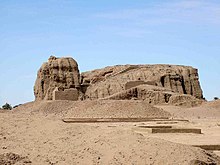Kerma (Sudan)
Kerma is an ancient city in Nubia , in what is now Sudan .
location
Today's place Kerma is located south of the third cataract of the Nile in the state of Ash-Shamaliyya , about 53 kilometers north of Dongola on the eastern side of the Nile . The former city complex , now called Doukki Gel , is located about 5 kilometers south of the village and a few 100 meters east of the thoroughfare, surrounded by fields and date palm forests . The remains of an Egyptian city are half a kilometer northeast of here. About 3 kilometers east of the irrigated fields in the desert is the large cemetery with an extension of 1.5 kilometers in a north-south direction.
history
At the beginning of the 2nd millennium BC The place was the center of the Kerma culture , a prehistoric culture that developed into a kingdom with significant influence. The city's central facility was a large, massive adobe building, which is now known as the lower or western Deffufa ( Nubian "brick ruin "). The function of the 19-meter-high and widely visible building is controversial, it was either a palace or a temple. In addition to numerous residential buildings, it was also possible to excavate large tombs from this period, which obviously served the kings. These plants were round. There was evidence of human sacrifice. Numerous Egyptian objects could be found, which on the one hand have certainly been traded, on the other hand they may have been captured during military campaigns. When the empire fell, Kerma was taken by the Egyptians.
The Egyptian city flourished until the end of the Meroitic period. It is the pnubs known from the sources .
The center of the city was a temple of Amun , which was built under Thutmose IV , although there were probably older buildings here. Under Akhenaten the building was converted into an Aton temple . In the 25th Dynasty, the temple was completely rebuilt under Shabaka . A hiding place dates from the Aspelta period and contained seven statues of Nubian rulers, which are now exhibited in the Kerma Museum. Further construction work took place under Arikamaninote .
In the Meroitic period, the whole temple complex was completely rebuilt again. Fired bricks were mainly used as building material. The place was abandoned around AD 400.
exploration
In Kerma today, in the middle of the excavation area, which is surrounded by a modern mud brick wall, are the remains of a brick building that was probably the ruler's palace or an Egyptian trading post. This Deffufa and the entire complex has proposed Sudan as a UNESCO World Heritage Site . In addition, large tombs were found where the princes Kermas are buried. The co-burial of subordinates could be proven in the graves; one found painted ceramics and amulets made of Marienglas . The foundation walls uncovered during the exploration were covered again for their protection. Low walls erected above it are visible, which reveal the basic plan.
Karl Richard Lepsius stayed in Kerma ( called Kerman by him ) in June 1844 .
The excavations at Kerma were led by George Andrew Reisner in 1913 and 1916 . More recent excavations at Dokki Gel have been taking place since the mid-1990s under the direction of the University of Geneva.
literature
- Peter Lacovara: Kerma. In: Kathryn A. Bard (Ed.): Encyclopedia of the Archeology of Ancient Egypt. Routledge, London 1999, ISBN 0-415-18589-0 , pp. 404-06.
- Charles Bonnet, Charles Valbelle: Pharaohs from Black Africa . von Zabern, Mainz 2006, ISBN 978-3-8053-3648-2 .
Web links
media
- In the land of the black pharaohs. Documentation, 52 min., Production: Switzerland, 2005, director: Stéphane Goel, summary ( memento of October 3, 2008 in the Internet Archive ) by Arte.
Coordinates: 19 ° 38 ' N , 30 ° 25' E



